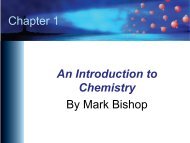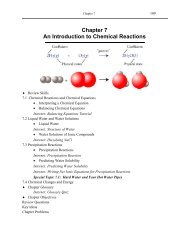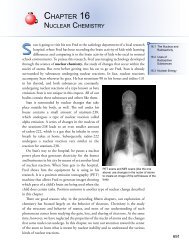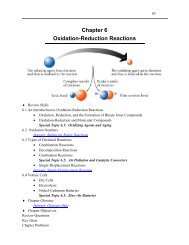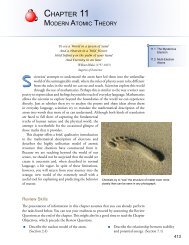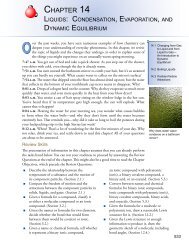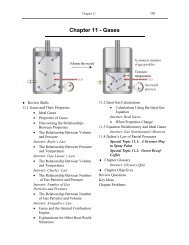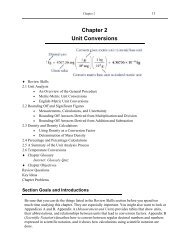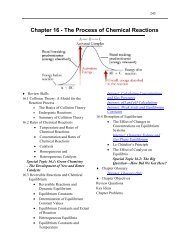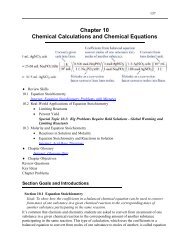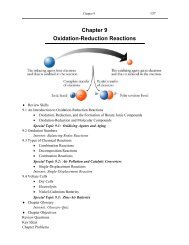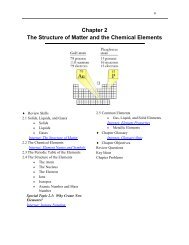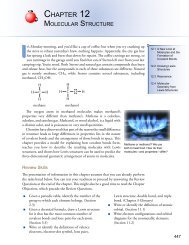Chapter 10 - An Introduction to Chemistry: Chemical Calculations ...
Chapter 10 - An Introduction to Chemistry: Chemical Calculations ...
Chapter 10 - An Introduction to Chemistry: Chemical Calculations ...
Create successful ePaper yourself
Turn your PDF publications into a flip-book with our unique Google optimized e-Paper software.
<strong>Chapter</strong> Problems 409<br />
79. What is the molarity of a solution made by dissolving 37.895 g of CoCl 2 in<br />
water and diluting with water <strong>to</strong> 250.0 mL <strong>to</strong>tal?<br />
80. What is the molarity of a solution made by dissolving <strong>10</strong>0.065 g of SnBr 2 in<br />
water and diluting with water <strong>to</strong> 1.00 L <strong>to</strong>tal?<br />
81. Sodium dichromate, Na 2 Cr 2 O 7 , can be made by reacting sodium chromate,<br />
Na 2 CrO 4 , with sulfuric acid.<br />
2Na 2 CrO 4 + H 2 SO 4 → Na 2 Cr 2 O 7 + Na 2 SO 4 + H 2 O<br />
a. What is the minimum volume of 18.0 M H 2 SO 4 necessary <strong>to</strong> react<br />
completely with 15.345 kg of sodium chromate, Na 2 CrO 4 ?<br />
b. What is the maximum mass, in kilograms, of sodium dichromate that can<br />
be formed from the reaction of 203 L of 18.0 M H 2 SO 4 ?<br />
82. A precipitation reaction takes place when a water solution of sodium carbonate,<br />
Na 2 CO 3 , is added <strong>to</strong> a water solution of chromium(III) nitrate, Cr(NO 3 ) 3 .<br />
a. Write a balanced equation for this reaction.<br />
b. What is the maximum mass of chromium(III) carbonate that will<br />
precipitate from a solution prepared by adding an excess of a Na 2 CO 3<br />
solution <strong>to</strong> <strong>10</strong>.00 mL of 0.<strong>10</strong>0 M Cr(NO 3 ) 3 ?<br />
83. A precipitation reaction takes place when a water solution of potassium<br />
phosphate, K 3 PO 4 , is added <strong>to</strong> a water solution of cobalt(II) chloride, CoCl 2 .<br />
a. Write a balanced equation for this reaction.<br />
b. What is the maximum mass of cobalt(II) phosphate that will precipitate<br />
from a solution prepared by adding an excess of a K 3 PO 4 solution <strong>to</strong><br />
5.0 mL of 1.0 M CoCl 2 ?<br />
84. Consider the neutralization reaction between nitric acid and aqueous barium<br />
hydroxide.<br />
a. Write a conversion fac<strong>to</strong>r that shows the ratio of moles of nitric acid <strong>to</strong><br />
moles of barium hydroxide.<br />
b. What volume of 1.09 M nitric acid would be necessary <strong>to</strong> neutralize the<br />
hydroxide in 25.00 mL of 0.159 M barium hydroxide?<br />
85. Consider the neutralization reaction between sulfuric acid and aqueous lithium<br />
hydroxide.<br />
a. Write a conversion fac<strong>to</strong>r that shows the ratio of moles of sulfuric acid <strong>to</strong><br />
moles of lithium hydroxide.<br />
b. What volume of 0.505 M sulfuric acid would be necessary <strong>to</strong> neutralize the<br />
hydroxide in 25.00 mL of 2.87 M lithium hydroxide?<br />
86. Consider the neutralization reaction between hydrochloric acid and solid zinc<br />
carbonate.<br />
a. Write a conversion fac<strong>to</strong>r that shows the ratio of moles of hydrochloric acid<br />
<strong>to</strong> moles of zinc carbonate.<br />
b. What volume of 0.500 M hydrochloric acid would be necessary <strong>to</strong><br />
neutralize and dissolve 562 milligrams of solid zinc carbonate?<br />
87. Consider the neutralization reaction between nitric acid and solid cadmium<br />
hydroxide.<br />
a. Write a conversion fac<strong>to</strong>r that shows the ratio of moles of nitric acid <strong>to</strong><br />
moles of cadmium hydroxide.<br />
b. What volume of 3.00 M nitric acid would be necessary <strong>to</strong> neutralize and<br />
dissolve 2.56 kg of solid cadmium hydroxide?



